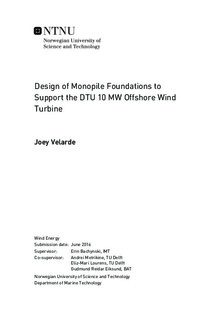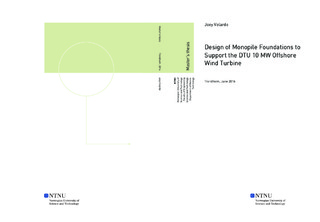| dc.description.abstract | Further advancements in the offshore wind industry, which come with the use of larger wind turbines at deeper water, require larger support structures. For shallow and intermediate water depths, monopile foundations still remain the most widely-used and cost-effective support structure due to the relative simplicity of fabrication and installation. The aim of this study is to investigate the challenges and feasibility of extending monopile technology for larger wind turbines and deeper water.
Preliminary monopile designs to support the DTU 10 MW reference wind turbine were established for water depths 20 m, 30 m, 40 m and 50 m. For large diameter piles, applying lateral soil stiffness derived from API method underpredicts lateral deflections at both seabed and pile toe. To properly account for the pile-structure interaction and the rigid pile behaviour, lateral soil stiffness was derived using finite element software Plaxis 3D.
To verify the preliminary design, ULS and FLS analyses were done using 1st order and 2nd order wave models applied with Morison s equation. For the ULS analysis, the 2nd order wave model predicts a response which is 1.9 times higher than the 1st order prediction for a water depth of 20 m. The sum-frequency effects and higher wave particle acceleration for the 2nd order wave model explain this result. For the FLS analysis, it was found that designing monopiles for higher water depths increases contribution of hydrodynamic loads to fatigue damage. A more sophisticated wave model is desired to increase accuracy in fatigue damage prediction at deeper water.
Lastly, a method for predicting total fatigue damage using a fewer number of representative sea states is introduced. A Fatigue Damage Parameter (FDP) is established to correlate fatigue damage to environmental condition by means of thrust, Hs and Tp. Using at least 30% of the total number of conditions results in at least 90% accuracy in damage prediction. The applicability of the method to other structures and environments is left for future work. | |

